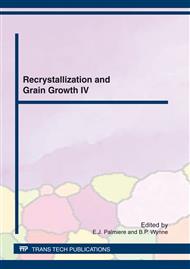[1]
Y.M. Chiang, D. Birnie III and W. D. Kingery: Physical Ceramics: Principles for Ceramic Science and Engineering, Chapter 5 Microstructure, pp.351-513 (John Wiley & Sons, New York, 1997).
Google Scholar
[2]
S.J.L. Kang: Sintering: Densification, Grain Growth & Microstructure, Chapter 2 Thermodynamics of Curved Interfaces, pp.9-18 and Chapter 15 Grain Shape and Grain Growth in a Liquid Matrix, pp.205-226 (Elsevier Butterworth-Heinemann, Oxford, 2005).
DOI: 10.1016/b978-075066385-4/50015-7
Google Scholar
[3]
S.Y. Choi and S.J.L. Kang, Acta Mater., Vol. 52 (2004), p.2937.
Google Scholar
[4]
D.Y. Yoon and Y.K. Cho, J. Mat. Sci. Vol. 40 (2005), p.861.
Google Scholar
[5]
H. Gleiter, Acta Metall. Vol. 17 (1969), p.853.
Google Scholar
[6]
C.M.F. Rae and D.A. Smith, Phil. Mag. A Vol. 41 (1980), p.477.
Google Scholar
[7]
S.E. Babcock and R.W. Balluffi, Acta Metall. Vol. 37 (1989), p.2367.
Google Scholar
[8]
K.L. Merkle and L.J. Thompson, Mat. Lett. Vol. 48 (2001), p.188.
Google Scholar
[9]
S.B. Lee and Y.M. Kim, Acta Mater. Vol. 57 (2009), p.5264.
Google Scholar
[10]
D.Y. Yoon, C.W. Park and J.B. Koo, in Ceramic Interfaces 2, edited by S.J.L. Kang, Institute of Materials, London (2001), p.2.
Google Scholar
[11]
Y.I. Jung, D.Y. Yoon and S.J.L. Kang, J. Mater. Res., Vol. 24 (2009), p.2949.
Google Scholar
[12]
J.P. Hirth and G.M. Pound, in: Condensation and Evaporation-Nucleation and Growth Kinetics, edited by B. Chalmers, volume 11 of Progress in Materials Science, Pergamon Press, Oxford (1963), p.77.
Google Scholar
[13]
J.P. van der Erden, in: Handbook of Crystal Growth Vol. 1, Fundamentals Part A, Thermodynamics and Kinetics, edited by D.T.J. Hurle, Elsevier Science Publishers, Amsterdam (1993) p.447.
Google Scholar
[14]
S.D. Peteves and R. Abbaschian, Metall. Trans. A, Vol. 22 (1991), p.1271.
Google Scholar
[15]
S.M. An, S.Y. Chung and S.J.L. Kang, to be published.
Google Scholar
[16]
S.Y. Choi, D.Y. Yoon and S.J.L. Kang, Acta Mater., Vol. 52 (2004), p.3721.
Google Scholar
[17]
J.H. Back, M.J. Kim and D.Y. Yoon, J. Am. Ceram. Soc., Vol. 88 (2005), p.3177.
Google Scholar
[18]
B.K. Lee, S.Y. Chung and S.J.L. Kang, Acta Mater., Vol. 48 (2000), p.1575.
Google Scholar
[19]
H. Moon, B.K. Kim and S.J.L. Kang, Acta. Mater., Vol. 49, (2001), p.1293.
Google Scholar
[20]
S.K. Kwon, S.H. Hong, D.Y. Kim and N.M. Hwang, J. Am. Ceram. Soc., Vol. 83 (2000), p.1247.
Google Scholar
[21]
S.J.L. Kang, M.G. Lee and S.M. An, J. Am. Ceram. Soc., Vol. 92 (2009), p.1464.
Google Scholar
[22]
S.Y. Chung and S.J.L. Kang, J. Am. Ceram. Soc., Vol. 83 (2000), p.2828.
Google Scholar
[23]
H.Y. Lee, J.S. Kim and D.Y. Kim, J. Am. Ceram. Soc., Vol. 85 (2002), p.977.
Google Scholar
[24]
P. Bennema and G.H. Gilmer, in: Crystal Growth: An Introduction, edited by P. Hartman, Volume 1 of North-Holland Series in Crystal Growth, edited by W. Bardsley, D.T.J. Hurle and J.B. Mullin, North-Holland/American Elsevier, Amsterdam (1973).
Google Scholar
[25]
J.G. Fisher, S.Y. Choi and S.J.L. Kang, J. Am. Ceram. Soc., Vol. 89 (2006), p.2206.
Google Scholar
[26]
Y.I. Jung, S.Y. Choi and S.J.L. Kang, Acta Mater., Vol. 54 (2006), p.2849.
Google Scholar
[27]
Y.M. Chiang, D. Birnie III and W. D. Kingery: Physical Ceramics: Principles for Ceramic Science and Engineering, Chapter 2 Defects in Ceramics, pp.101-184 (John Wiley & Sons, New York, 1997).
Google Scholar
[28]
E.D. Williams, Surface Science, Vol. 299/300 (1994), p.502.
Google Scholar
[29]
B.K. Lee, S.Y. Chung and S.J.L. Kang, J. Am. Ceram. Soc., Vol. 83 (2000), p.2858.
Google Scholar
[30]
B.K. Lee and S.J.L. Kang, Acta Mater., Vol. 49 (2001), p.1373.
Google Scholar
[31]
S.Y. Chung, D.Y. Yoon and S.J.L. Kang, Acta Mater., Vol. 50 (2002), p.3361.
Google Scholar
[32]
S.M. An and S.J.L. Kang, Acta Mater., Vol. 59 (2011), p. (1964).
Google Scholar


